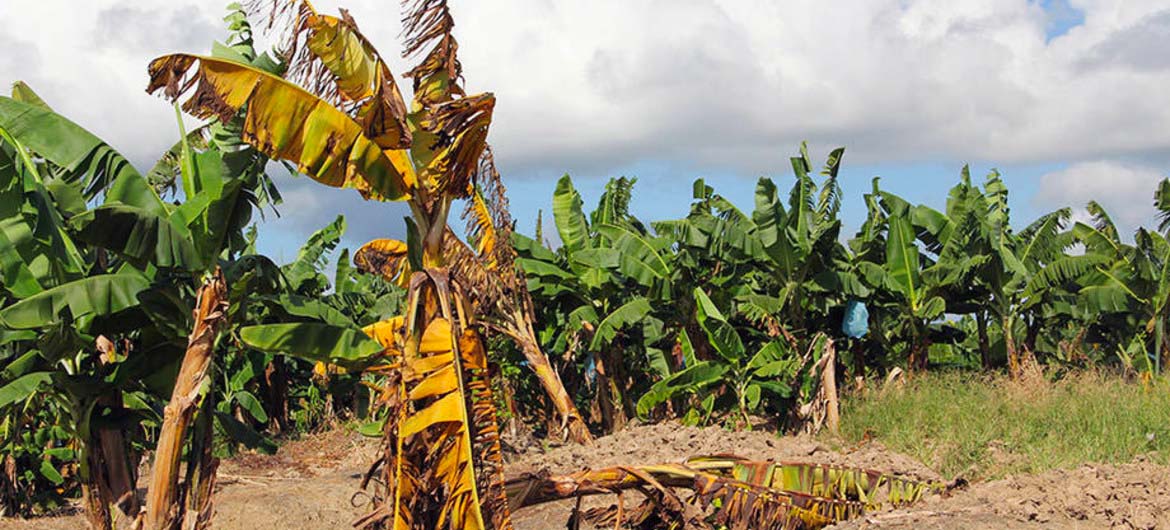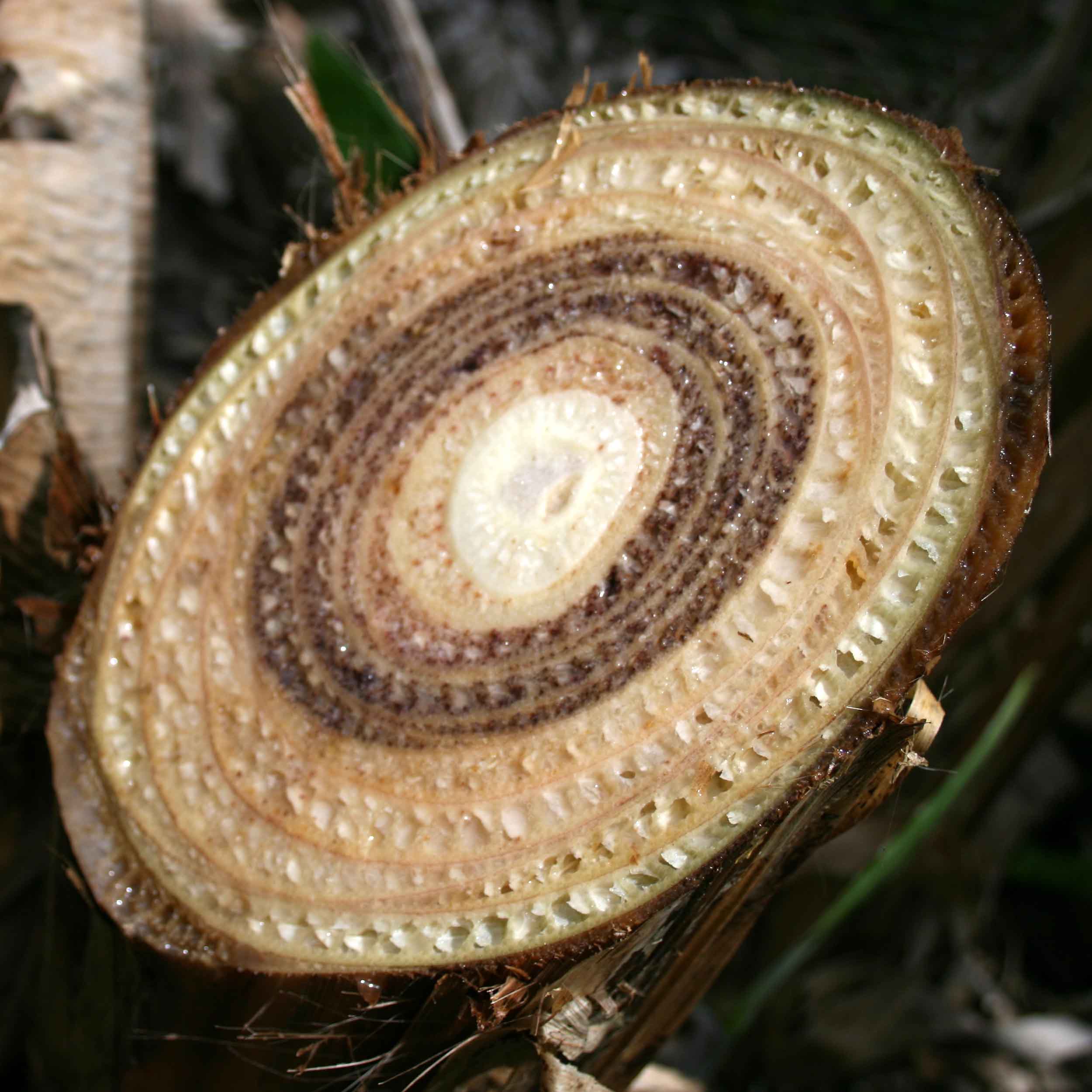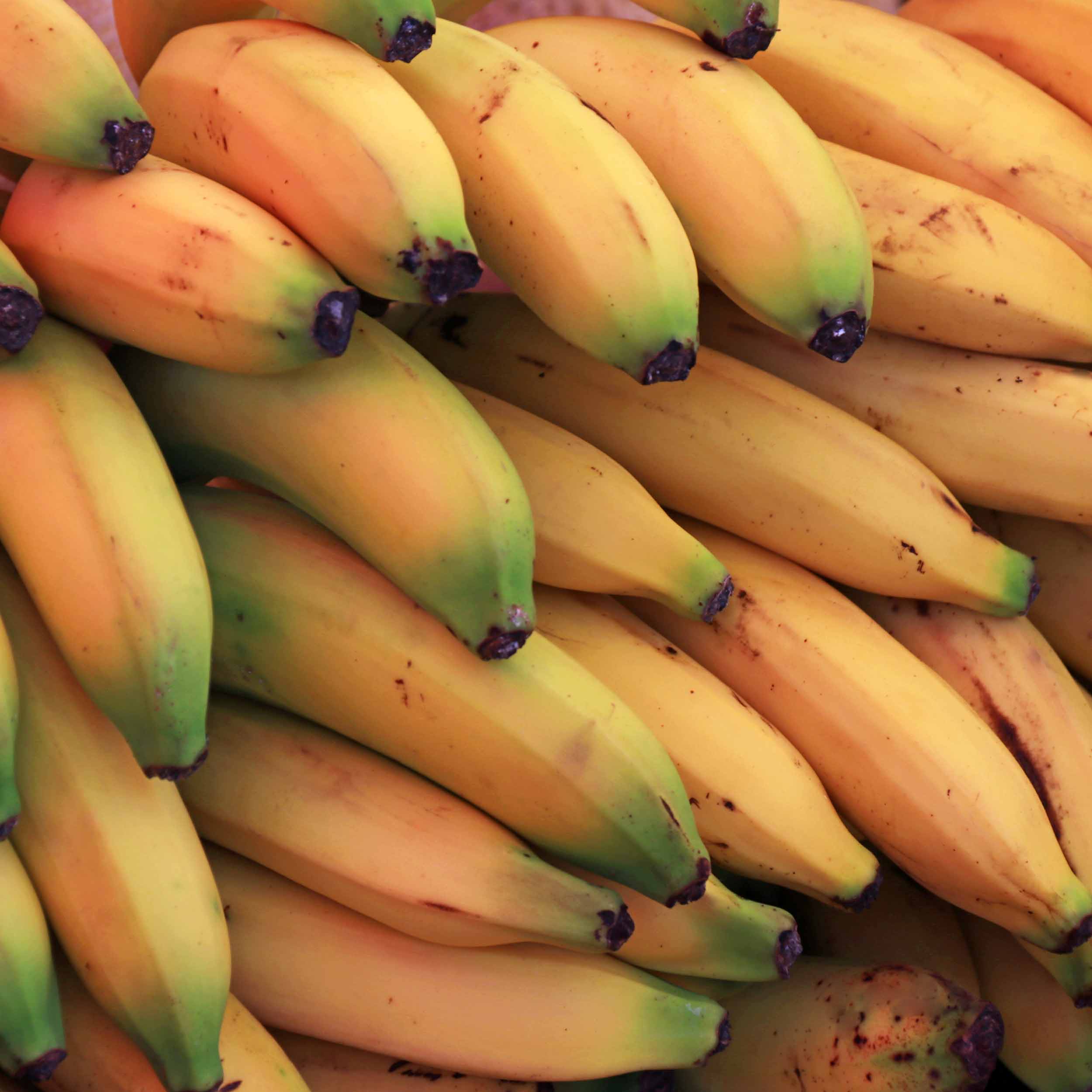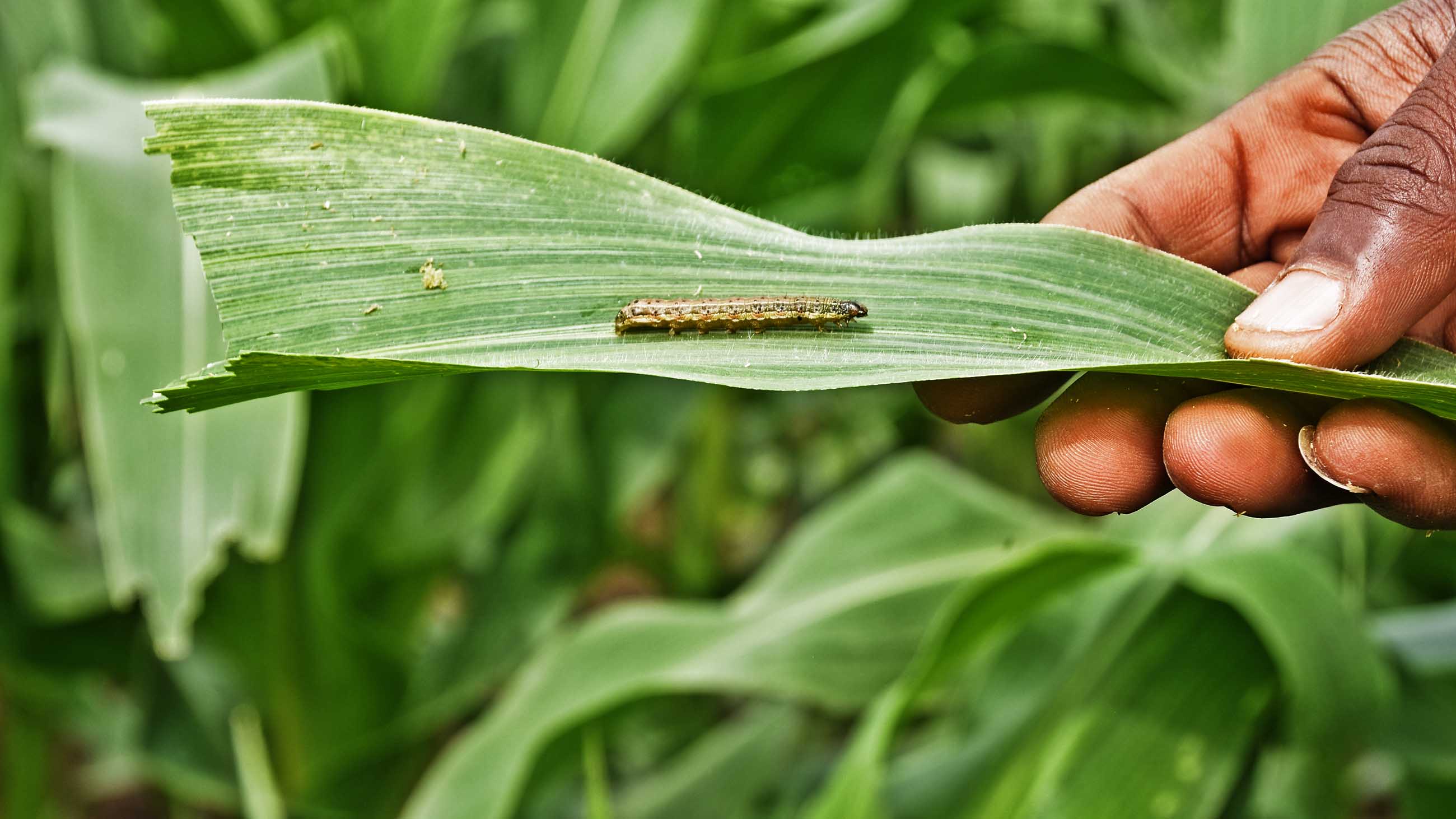Preparing for Invasive Pests Before They Arrive
Last November, a group of scientists and government officials met at the Hotel Himalaya in Kathmandu, Nepal, to attend a workshop focusing on a larval moth called the fall armyworm (Spodoptera frugiperda). The gathering, hosted by the Center for Agriculture and Biosciences International (CABI), included presentations and group work on the topics of pheromone lures and how to identify the pest, which feeds on more than 80 plant species, including rice and sorghum, but prefers maize. The head of the National Plant Protection Organization of Nepal was also in attendance.
A few days later, the International Maize and Wheat Improvement Center (CIMMYT), the USAID-funded Feed the Future Nepal Seed and Fertilizer Project and Feed the Future Innovation Lab for Integrated Pest Management, along with Plant Protection Society Nepal, held a joint workshop of their own on the fall armyworm.
All of this for an insect that had never been seen in the country.
Non-native species cost global economies $1.4 trillion annually. They threaten biodiversity and food security, can spread disease, and even compromise physical infrastructure. And yet, despite the known threats, pest management tends to be reactive: An insect or disease arrives, farmers take notice, and then scientists and advocacy groups show up and everyone scrambles for money while mitigating the damage as best they can.
But with increased globalization and climate change, there is an intensifying focus by governments and nongovernmental organizations on preparing for invasive species before they arrive, especially in the places most vulnerable to injurious impacts.
According to Regan Early, a senior lecturer in conservation biology at Exeter University, invasive species used to be primarily a so-called first world problem. Historically, Europe and North America had the most trade and were therefore most vulnerable to invasive arrivals from abroad, such as the Asian citrus psyllid, the giant African snail, and the Asian longhorned beetle. But because of globalization, invasive species are increasingly becoming everyone’s problem, affecting countries without the money, technology, or know-how to deal with them.
What’s worse, Early adds, the relatively recent growth in trade among countries in the Southern Hemisphere makes it hard to predict which species might travel where and cause the most problems. “We’re only just starting to see which kinds of species can make the inter-continental jump,” she says.
In 2016, Early and other scientists published a paper that identified the countries at the greatest risk for potential invasion by crop pests and those that are least prepared for their arrival. “Africa is showing up as ‘red,’ as having virtually no proactive capacity, no programs in place that have successfully managed invasive species in the past,” Early says. “They’re not thinking about which new species might arrive and there’s no coordination.”
The paper, which also highlighted nations in Central America and Central and Southeast Asia as among the least prepared, was written just before confirmation of the arrival of the fall armyworm in Nigeria and São Tomé and Príncipe in early 2016. Africa was unprepared for the species’ arrival and was only able to respond reactively. Many farmers weren’t even aware of the fall armyworm until it showed up in their fields, and they responded by spraying often highly toxic pesticides in arbitrary amounts.
The fall armyworm is native to tropical and subtropical regions of both North and South America. Although it is still not known exactly how it arrived in West Africa, Early believes it traveled on a passenger plane. It is currently reported or confirmed in nearly all of sub-Saharan Africa and is estimated to have caused roughly $13 billion in crop losses on the continent through 2018. In the summer of 2018, it was confirmed in India, followed by Sri Lanka, Yemen, Bangladesh, Myanmar, Thailand, and most recently, China, the world’s second-largest maize grower.
Because the fall armyworm expands its range so quickly, there is no real hope of stopping its spread. Instead, groups like CABI, the U.N.’s Food and Agriculture Organization (FAO), and the International Center for Insect Physiology and Ecology, along with local and foreign governments, are trying to raise awareness in countries that are likely to be invaded. For countries on the moth’s flight path, preparation means setting up pheromone lures so they can know as soon as possible when it arrives; training farmers in proper use of pesticides and the best time to use them; creating a habitat for natural predators, like ants and earwigs; learning about local maize systems to use intercropping as a means of control; and educating local agronomists on naturally occurring biological agents such as pathogens and parasitoids.
At the same time, researchers are trying to predict where the fall armyworm will head next. In 2018, Early and colleagues published a paper modeling its spread: their research identified Australia, China, India, Indonesia, Malaysia, the Philippines, and Thailand as the countries most at risk. By the time the paper was published, the fall armyworm was already confirmed in India, but their predictions have raised awareness in other nations and are helping organizations and governments mitigate future damage
“There are two elements to risk,” says Roger Day, CABI’s program executive for their Action on Invasives program and one of the leaders of the November workshop in Kathmandu. “One is the likelihood of [a pest] getting there and the other is what is the consequence when it gets there.”
To help the workshop participants, who were mostly national plant protection officers from Nepal, Bangladesh, India, and Sri Lanka, think about risk, Day had them evaluate the probability and impact of certain events — like “catching a common cold in the next year” and “being hit by an asteroid during your life” — on a scale from “very low” to “very high.” Using that framework, the workshop then turned to specific pests to gauge which species pose the most risk to their countries, identifying which pests were more likely to arrive and which would cause the greatest crop losses. Besides fall armyworm, other pests included the cassava mealybug, wheat blast, and Tuta absoluta, also known as the South American tomato leafminer.
“The name of the game here is to identify what the highest risks are so you can concentrate your effort on trying to reduce those risks, because it’s almost impossible to try and cope with everything,” Day says. “At least you can avoid this panic and headless-chicken response.”
Unfortunately, according to Day, there is often relatively little awareness of what threats are in the neighborhood, so the workshop paired up participants from countries where the pest already thrives with those from countries where it was likely to migrate. “In a short workshop this process can only just begin,” he says, “but the hope was that by making those links, subsequent communication might occur.”
National borders are human creations, of course, and insects and fungal diseases don’t abide by them. So even if an entire country could eradicate the fall armyworm, it would probably invade from a neighboring country all over again. This makes communication and coordination critical. “Internationally, we could share information on crop pests much better than we do already,” Early says.



This is the goal of the FAO’s Global Program on Banana Fusarium Wilt Disease, created in partnership with the World Banana Forum, the International Institute of Tropical Agriculture, and Biodiversity International. Until the 1950s, if you bought a banana in a grocery store, it was likely to be a variety known as the Gros Michel. But after a fungal disease, Fusarium wilt, spread through banana plantations around the world, this variety was devastated, and was replaced with the one we currently eat, the Cavendish.
Now the Cavendish is also under threat from a new strain of Fusarium wilt called Tropical Race 4, which was first found on Cavendish bananas in Southeast Asia around 50 years ago. Unlike the fall armyworm, the fungus isn’t airborne but spreads through movement of infected plant materials and infested soil particles by pathways such as floods, irrigation or drainage water, and farm tools and machinery. It can also be transmitted accidentally by workers and visitors on banana plantations who get it on their clothing or boots and take it with them to another location. In the 1990s, it devastated Cavendish plantations in Indonesia and Malaysia. After moving slowly through Southeast Asia, it was found in the Middle East. Then, surprisingly, it showed up in Mozambique.
“That was a real shock and worry to the global community because it was the first time this strain, the TR4 strain, was identified in Africa,” says Fazil Düşünceli, an agriculture officer at the FAO. “And knowing the situation in Africa, the difficulties in border controls, and the lack of capacities, the global community became worried about this threat. We thought we should do something at the global level — alert people, alert countries.”
The goal now is to prevent the fungus from reaching the rest of Africa. Although the risk for spread is still there, so far it seems to be contained in Mozambique, thanks in some part to increased awareness among farm workers, improved phytosanitary methods, and isolation of new infection appearances. They are also trying to prevent the disease from traveling to Latin America, another big banana producing area, as well as encouraging countries to share their experiences and strategies.
“In most of these developing countries, there are not many experts knowing the disease, says Düşünceli. “So we try to support the training activities in these countries. And in some cases, we also provide support for rehabilitation of labs in disease diagnosis and surveillance.”
Although prevention isn’t always an option, invasive species can be forestalled, and countries can be better prepared for when they do eventually arrive. To this end, Early is finishing a report for CABI forecasting where the South American tomato leafminer will travel next.
The moth, which feeds on tomato leaves, migrated to Spain in 2006 and has since spread through Europe and the Middle East into Africa, where it has been called Tomato Ebola, and is now in Asia. Early’s research suggests that the moth is already naturalized in most of the places that are climatically suitable for it, but warns that it will spread more widely in Africa, the Arabian Peninsula, and Central Asia. She also says it will probably do well when it reaches southern China and in southern Australia, if it makes it that far.
“Interestingly,” she says, “It was hard to be as accurate for Tuta as for the fall armyworm. Tuta doesn’t seem to be as tied to precise climatic conditions.”
As for the fall armyworm, the Feed the Future Innovation Lab for Integrated Pest Management prepared a risk assessment for USAID’s Egyptian mission early last year. At the moment, the pest has not made it into North Africa, but it has already arrived in neighboring Sudan, and the irrigated areas along the Nile have crops that could host the fall armyworm, making Egypt vulnerable.
The European Union has its eye on the moth as well. Last June, the European Food Safety Authority produced a report assessing the likely pathways the fall armyworm might take in Europe and outlined ways to prevent it, such as limiting imports of certain crops from invaded countries. However, the report also concedes that once the pest gets a foothold in North Africa, there won’t be much to stop it from flying up to Southern Europe.
“Invasive species have terrible impacts everywhere,” Early says.
Stephanie Parker is a freelance environmental journalist based in Switzerland and North Carolina who focuses on agriculture, invasive species, and biodiversity. She has written for Civil Eats, Earth Island Journal, Mongabay, Science News, and Wired, among other publications.











Comments are automatically closed one year after article publication. Archived comments are below.
It’s kind of amaizing that you can write a piece like this and completely ignore the GMO projects on armyworm and banana diseases. Quite an oversight.